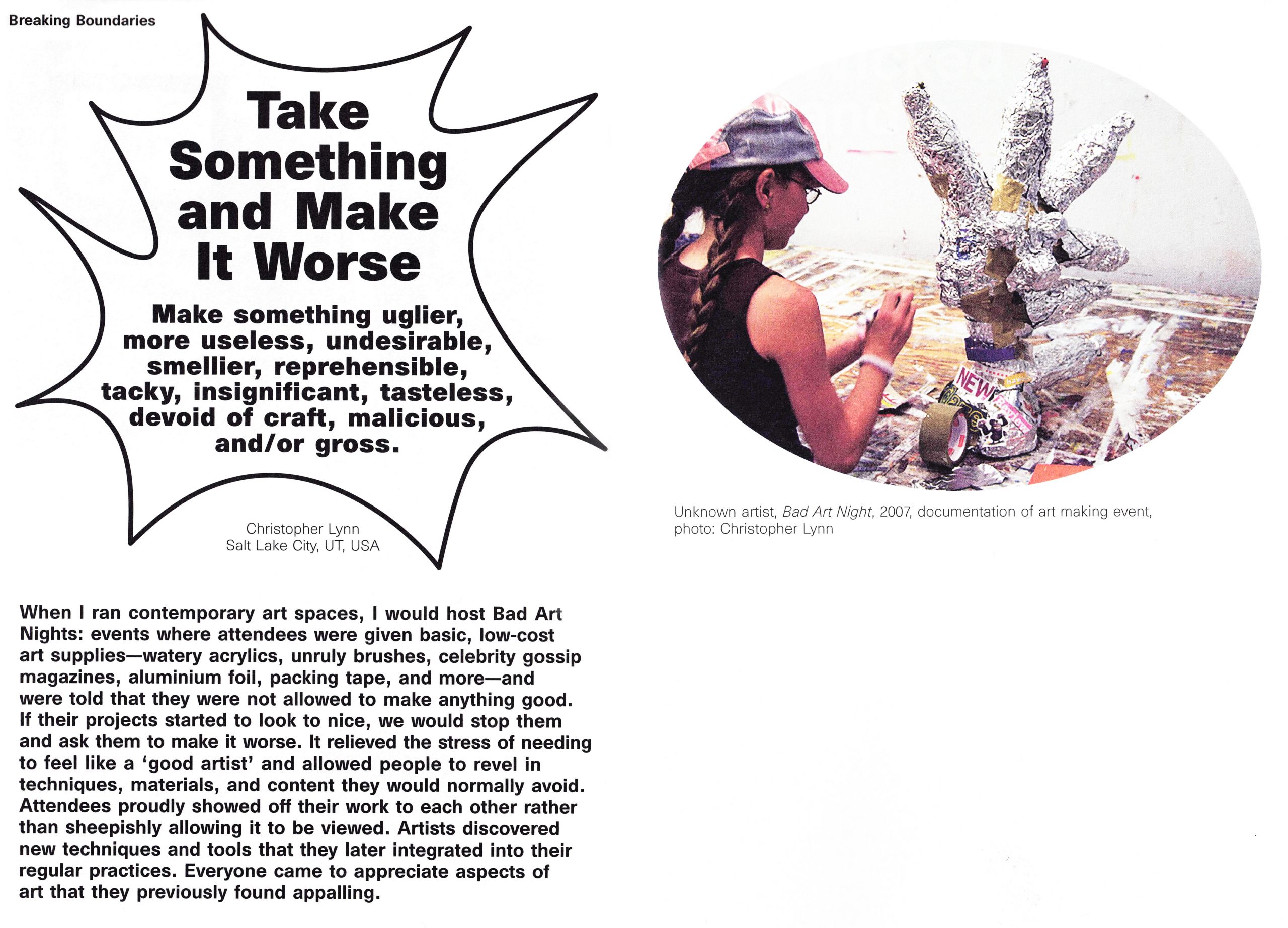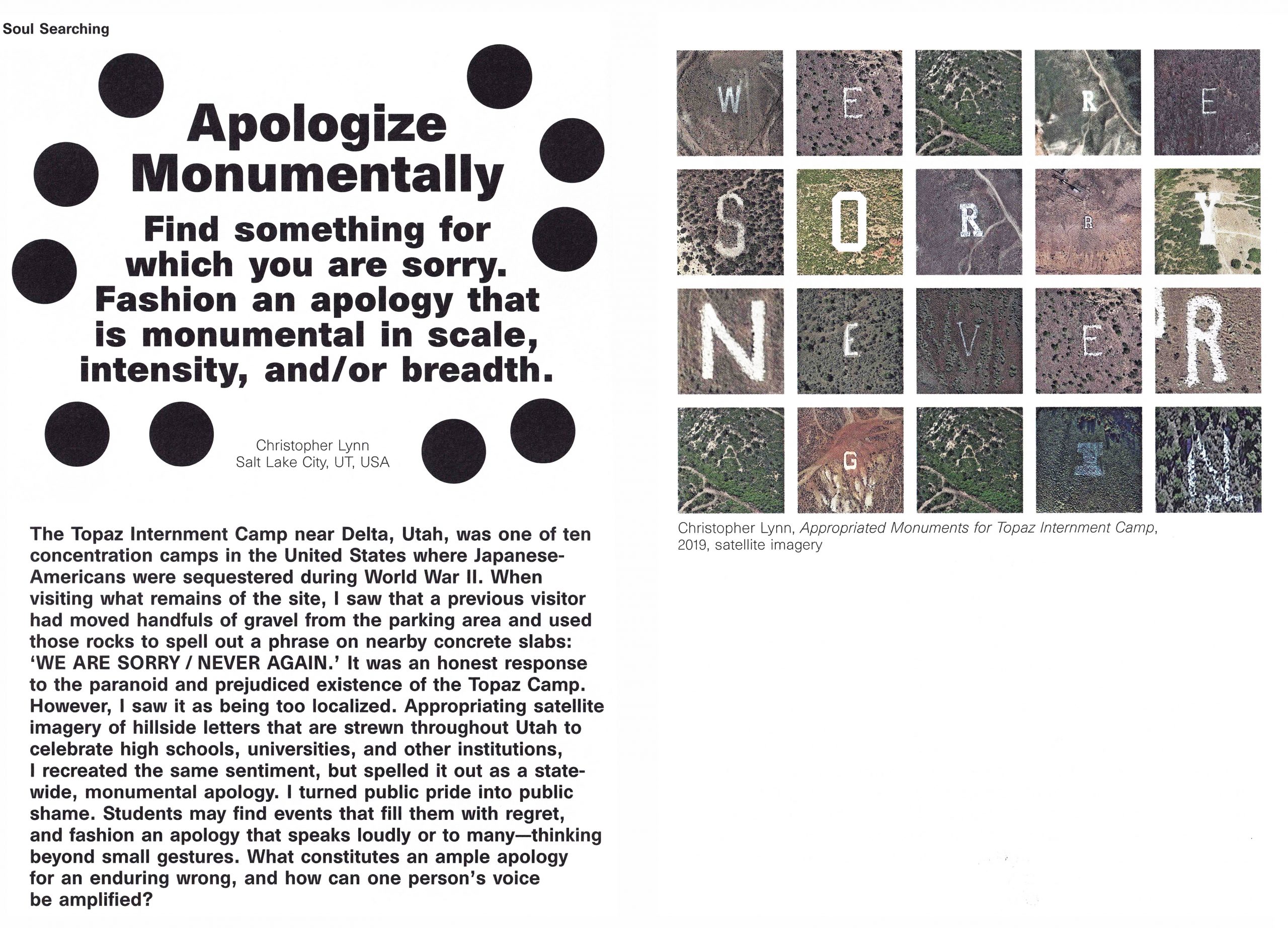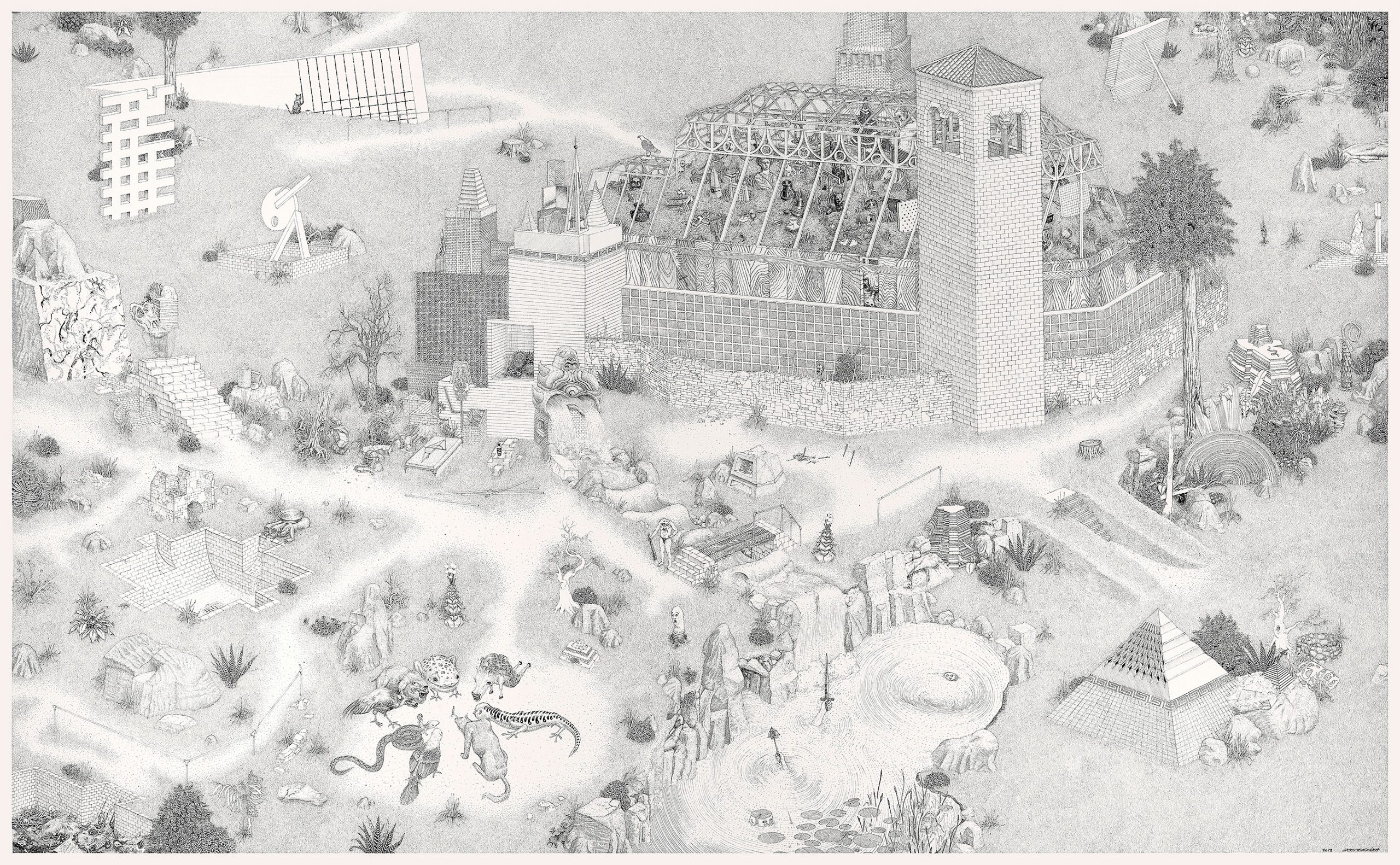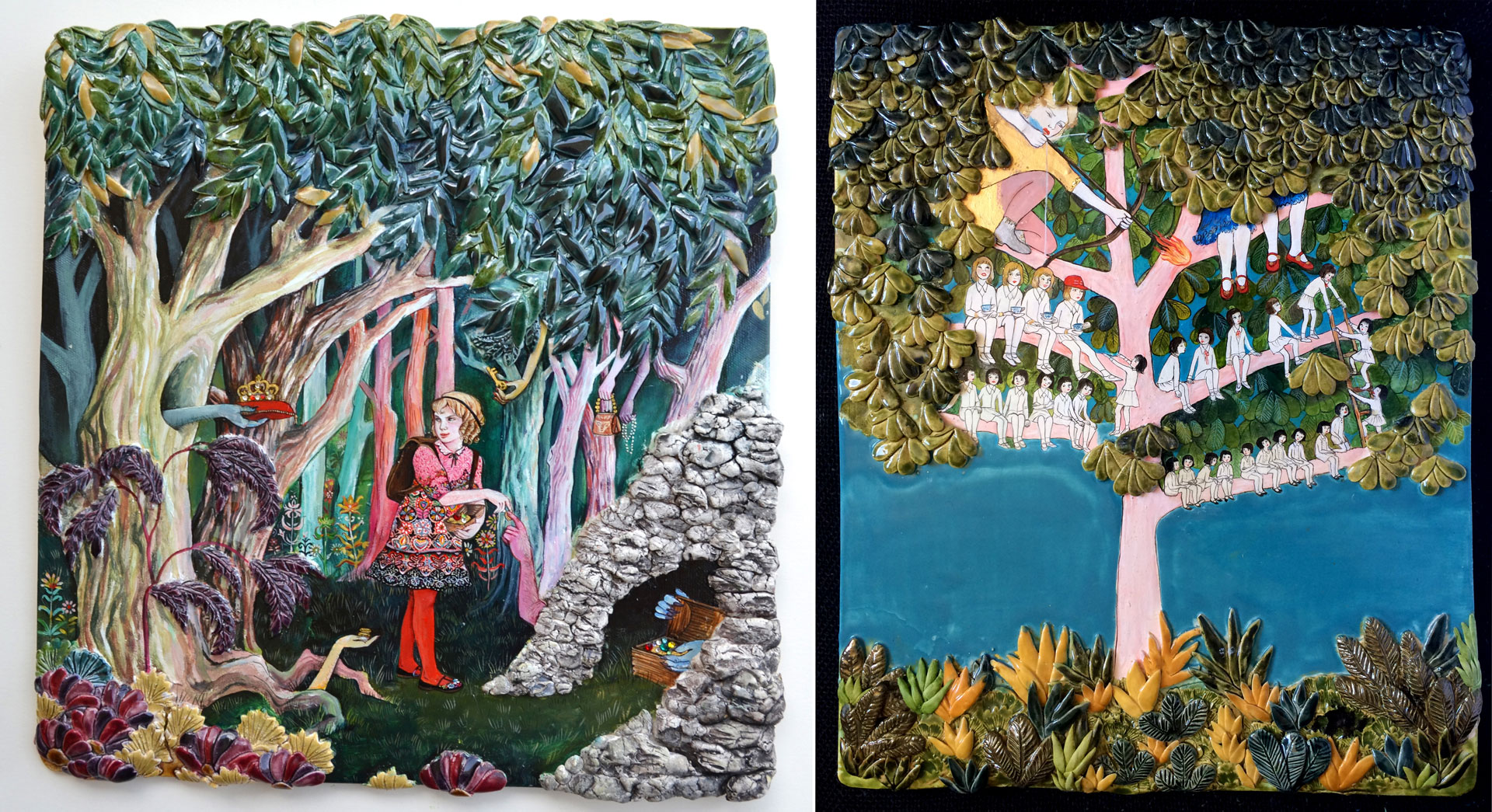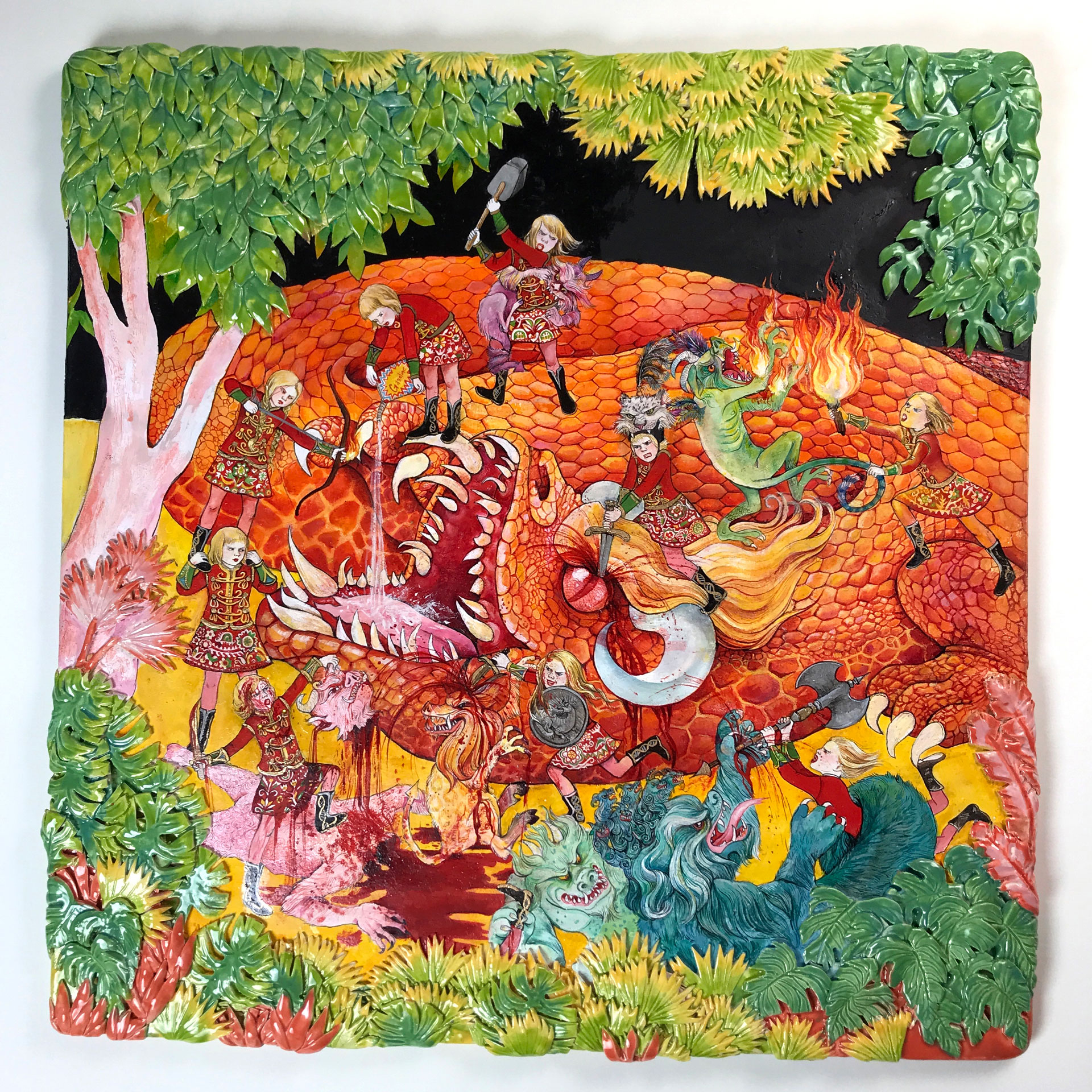Peaks and Valleys
New alternative platforms for presenting art were cropping up in Utah utilizing apartments, garages, the internet, and the desert landscape as their homes. This article is a snapshot of these spaces in 2020 as COVID-19 shut down physical spaces—highlighting the value of a virtual presence and documenting how others pivoted online.
Geologically, the state of Utah is a panoply of strata, formations, and colors. From the sterile expanses of the Bonneville Salt Flats, to the soaring peaks of the Wasatch Mountain Range, to the otherworldly red rock deserts of the south, Utah is constantly and slowly changing. Wind and water contour stone; floods and droughts reveal, and submerge the land; while underground volcanic, and tectonic activity pushes and pulls the surface into craggy wrinkles. A magnitude 5.7 earthquake shook northern Utah as recently as March this year.
In Utah’s evolving cultural landscape, there are only a few steadfast art museums that have weathered corroding social and economic factors over the decades, and of those, there is only one that is not directly tied to a university. Over the years, smaller, artist-initiated projects have emerged then eroded away. Such endeavors are generally founded to provide opportunities that would otherwise be absent given the paucity of galleries and museums. What has changed is the sheer number of initiatives that are continuing to crop up. They each have a stance on sustainability, engagement, and scope—variations that make their coexistence interesting, and relevant.
Pal Gallery started in Provo, Utah in the spring of 2018, with an apartment show of seven artists. Eric Edvalson, the curator, and organizer who recently graduated from Brigham Young University’s (BYU) MFA program, initially thought of it as a one-time thing, but also considered lending the project some legitimacy by naming the space. “There is something interesting about calling it a gallery, and stating that this is our first show.” Assuming that wearing the mantle of a gallery conveys authenticity, a platform is then established for artists to surpass the pall of amateur endeavors, and invite people into their homes, welcome other artists, and avoid the awkwardness in offering casual approaches—“Hey, would you like to display your art in my house?”
Edvalson named his gallery Pal, because he saw it as a chance to build relationships—strengthen friendships he already had with his exhibiting artists, and form new connections by asking people into his sanctum. Given the spatial challenges of his apartment, the shows could only last for one night. He produced pocket-size print catalogs for each exhibition to document their fleeting nature, and used Instagram to advertise, and serve as his sole digital archive. The future of Pal is in question with the onset of COVID-19, when bringing strangers into one’s apartment is not currently an option, but it does provide Edvalson with time to reevaluate where, and how, he invests his energy and resources. He always hoped that Pal would be a catalyst, saying, (with tongue partially in-cheek) “Part of me doesn’t want to do these things. I’m just doing them because no one else will. And if other people start doing it, then I won’t have to.” This do-it-yourself drive is very common in the arts in Utah. There is not a multi-tiered ecosystem in which artists can thrive. As such, artists must create their own opportunities, or languish waiting for others to lead the way.
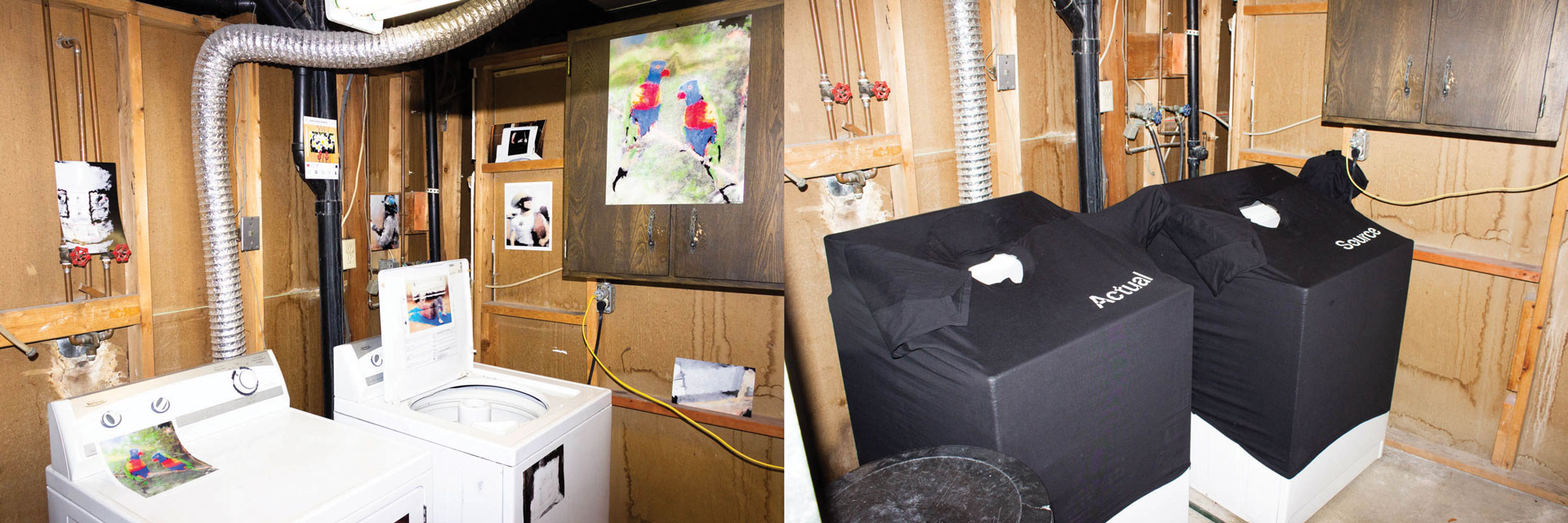
Brokkenfreute and Other Similar Pictures, 2020
Installed at Washer / Dryer Projects, 1/17/2020 – 2/14/2020
Image courtesy of the artist and Washer / Dryer Projects
Right: Actual Source, Beefy T, 2019
Installed at Washer / Dryer Projects, 9/7/2019–9/30/2019
Image courtesy of the artist and Washer / Dryer Projects
Another BYU alumnus, Mitchell Barton, sought to fill those same opportunity gaps, in the fall of 2018. He didn’t have the funds to start a space, given Utah’s rising real estate prices. What he had, thought, was an unfinished laundry room that he thought would make a suitable antithesis to a sterile white-cube space. His wife was pregnant, and extremely sick at the time, so to reduce their stress, they decided no one would actually come to their apartment. They embraced their situation, and Washer / Dryer Projects became an exhibition space that was only publicly accessible through online documentation. Work was physically installed, and photographed for Instagram, and the Washer / Dryer Projects site. Barton treated the shows as he would any public exhibition, keeping work up through the entire stated duration, and moving it only as needed to keep the laundry room functional. When their living situation changed, they no longer had a dedicated laundry room, so Barton invited others to franchise the idea, resulting in upcoming projects in other artists’ laundry rooms.
For many Utah artists—as elsewhere—the digital realm is a more manageable and efficient location for artistic dissemination. Most art that is consumed is via photos on the internet, rather than in-person experiences. Their own artistic output is also more likely to end up on Instagram or web-based portfolios than in a bricks and mortar gallery. Such physical sites are no longer the ultimate destination. Documentation has expanded the chances of professionally beneficial outcomes, while still adhering to traditional presentation standards.

Installation screenshots courtesy of artists and Madeline Rupard
Radical Hope is a good example of this approach. Initiated by Madeline Rupard—who studied at BYU, and is now based in New York—its curatorial team includes Utah-based artist Aloe Corry, Pittsburgh-based Isabelle Brourman, and Ohio-based Connie Fu. The affirmative project opened May 28th, 2020, and was built using ArtSteps, an online platform that employs a 3D gaming engine to create virtual environments, with a retro feel. Launching in the middle of the Coronavirus shutdown, the exhibition leveraged its decentralized nature to inexpensively assemble works from artists around the world into the bespoke space. The curators utilized this fantasy world to play with scale and display, free of physical limitations.
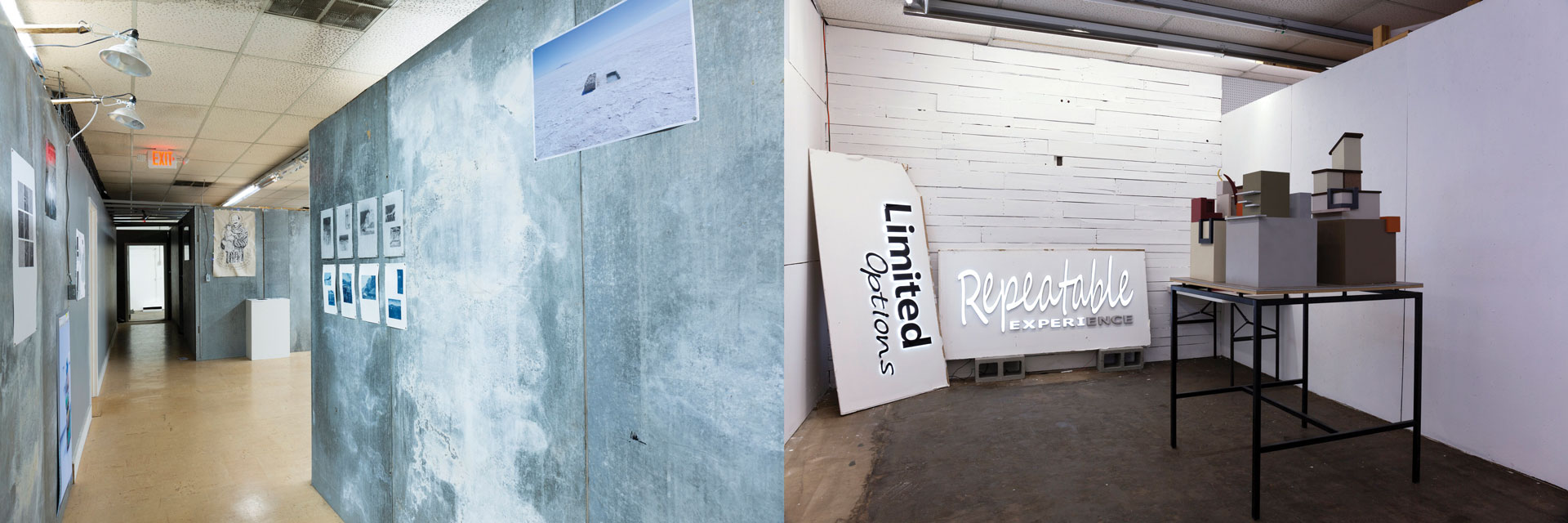
By PARC Collective
Image courtesy of the artists and PARC Collective
Right: Kelsey Harrison
Luxury My Way, 2019
Installed in MGNT exhibition by PARC Collective
Image courtesy of the artist and PARC Collective
The PARC Collective began when artist Ron Linn was looking to collaborate with, and support other cultural producers around Provo, where he was based. Initially, he approached the artists, Tiana Birrell, and Art Morrill. Since Birrell was living in Salt Lake City (forty-five minutes north) and Morrill lived near Ogden (a further half-hour north), they aimed to widen their net geographically. Their inaugural curatorial effort was an exhibition of emerging, and established artists from across the northern part of the state. After that, they brought on artist and designer Sarah Waldron Brinton to the collective. Before they could develop more of their plans, COVID-19 interrupted production, causing a necessary shift. Birrell spearheaded a partnership with the Granary Art Center, a more established, artist-run non-profit in Sanpete County, and the collective began curating from art submitted via Instagram. The result was Incubation Period, an online exhibition, and proposed publication. Linn has stated that, as an artist, he worked harder when he felt that his community was watching. He said that by assuming the role of an organized group, the PARC Collective could encourage other artists to work more fruitfully, and think more about what it means to be producing work in Utah.
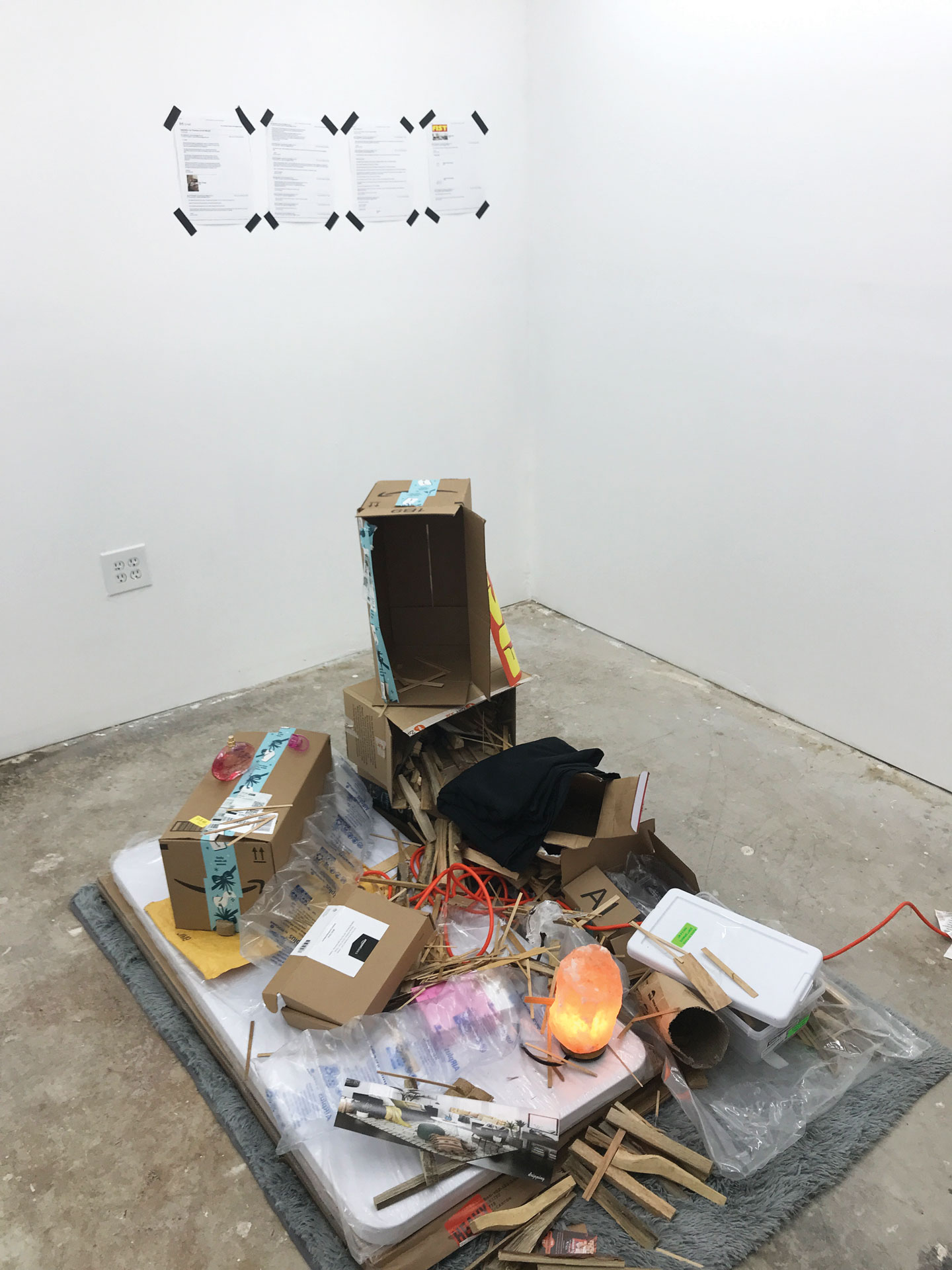
My Amazon Journey Boxes / From Heaven, 2020
Installed at the_openroom
Henry Becker, Nolan Flynn, Josh Graham, and Andrew Rice, inspired in part by Pal Gallery, rehabbed Becker’s garage into a small gallery space and named it the_openroom. They built-out programming that included exhibitions, and accompanying online artist presentations. The art is generally only accessible for one night, but their focus is on post-internet practices, which lends itself to digital documentation, and archiving. Since the pandemic isolation restrictions, they have shifted focus to online discussions with artists and curators, and teamed with the Utah Museum of Contemporary Art on an internet-based project that invites public collaboration on artists’ digital images. Of the individuals, and groups featured in this text, the_openroom is the only one to state that it is dedicated to a sustainable practice in Utah, rather than being provisional and ephemeral. Currently, their collective is entirely self-funded, but they see it as “investing in [their] culture.”
Final Hot Desert is the creation of artist Ben Sang. He attended Snow College, in remote Ephraim. Feeling distant from the art world he was studying, he spent a year researching and writing about contemporary artists. After accepting a corporate job, he dedicated his newfound disposable income to inviting artists to Utah to install their work in unique locations. His first exhibition consisted of work by two locals who responded to, and presented their work at, Robert Smithson’s Spiral Jetty. Later, Sang leveraged relationships he had cultivated over Instagram to invite national artists. He works with his guests to identify ideal locations for their work, which have included the Salt Flats, Little Cottonwood Canyon, and The Tree of Life sculpture near Wendover. There are no opening receptions or public viewings, only crisp photo-documentation that has earned his project an international reputation. For Sang, Final Hot Desert is about establishing and nurturing networks and relationships, and reaching out from Utah—which is often perceived as a cultural desert—to introduce himself, and his state to the outside world.
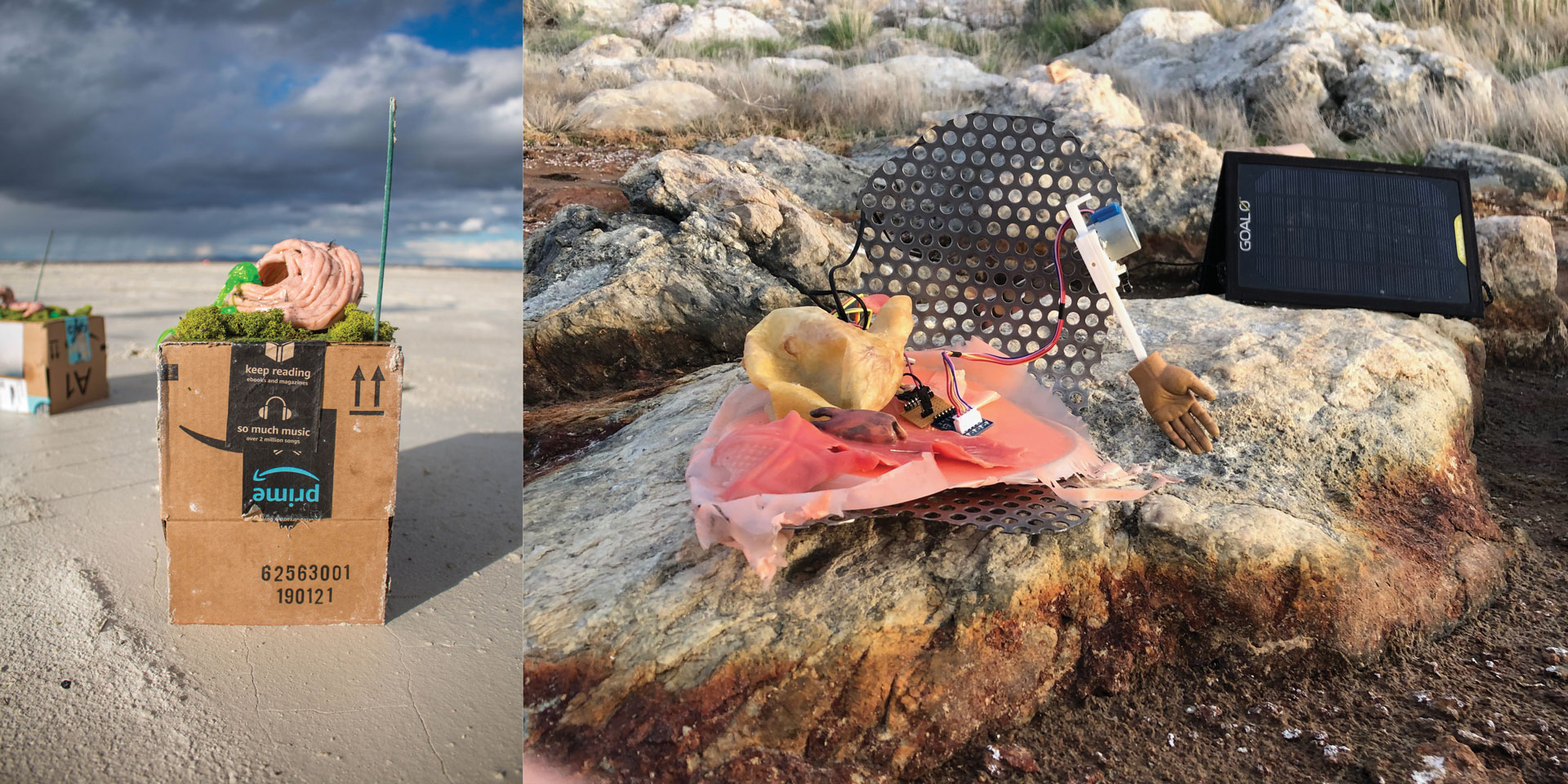
three dollar narrative (plus eternal shipping), 2019
Amazon box, clay, thread, melted plastic, fake mosses, fake eyelashes adhesives, photograph, light, incense, installed at the Tree of Life
Image courtesy of the artist and Final Hot Desert
Right: Natalia Janula
Laminar Body^ies~, May 7, 2020
Installed at the Great Salt Lake, Utah
Images courtesy of the artist and Final Hot Desert
The youthful optimism that permeates these examples has shaken the cultural ground of Utah. Artists are learning from these individual, and collective efforts, and are communicating, and networking across geographic divides as never before. They are experimenting within their artistic practices and with modes of installation and display. By encouraging and supporting each other, and in questioning the necessity of standard exhibition models, they are creating excitement, and establishing innovative working methodologies. Whether we are beginning an ascent to a lofty summit, or heading back down into a valley of cultural apathy is yet to be determined.
Riccardo D’Avola-Corte
You will never understand what your caresses leave on me…, July 14–August 20, 2019
Installed at the Bonneville Salt Flats, Utah
Image courtesy of the artist and Final Hot Desert
